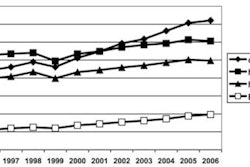
In my previous article, "Radiology groups need new approaches to survive in tough times," I compared the experiences of two radiology groups in seeking hospital financial support.
 |
| Healthcare business and legal affairs expert Mark F. Weiss. |
The first group, Community Imaging, relied simply on evidence of its physicians' shortfall in income to carry its argument that the hospital should provide the group with significant financial support as a part of its contract renewal. That strategy failed miserably.
The second radiology group, Memorial Imaging, engaged in an integrated series of planning and actions over an extended period of time, all aimed at positioning the group to obtain multimillion-dollar-per-year financial support. It achieved a highly successful result.
In this article, I'll outline seven of the many steps that Memorial Imaging took -- and that all radiology groups must take -- to achieve lasting, exclusive contract relationships that include high levels of financial support from hospitals.
Memorial Imaging devoted significant time to the process, which played out over the course of two years. Exclusive contract and stipend negotiation is not simply a back-and-forth, face-to-face discussion between the radiology group and the hospital. It is also all of the preparation and positioning done to get the group to that point. In order to achieve a transformational result, that positioning requires time, optimally several years, in respect of a contract renewal.
Memorial Imaging understood that successful groups establish a business strategy to which exclusive contracting and stipend support substrategies are aligned. The great majority of radiology groups have no strategic vision for their business -- they just perform medical services, patient after patient. Success requires that groups take the time to determine where they want to be at some definite point in the future. That imagined future is then used as a magnet to pull the group's business forward. Once that strategy is set, the group aligns its particular contracting substrategies and tactics so that they are consistent with the group's overall business strategy.
Memorial Imaging recognized that although the negotiation process takes time, it does not involve a timeline. Progress in positioning the group and conducting the negotiation is not linear. As it is presented in this article, the negotiation process involves an ongoing series of interrelated strategies and tactics. These elements, once started, continue both independently and dependently -- independently in that each is focused on a particular goal, but dependently in that each strategy and tactic supports the others in achieving the group's negotiation strategy, which in turn supports the group's overall business strategy. Instead of the image of a timeline, picture an atom: Each of the electrons revolves independently, but they all revolve around the nucleus.
Memorial Imaging understood the difference between a fair market value analysis and the negotiation of stipend support. A fair market value analysis is a necessary part of determining the permissibility of the amount of stipend support, but it is not the same as the process of convincing a hospital that a stipend is warranted or the process of actually establishing the amount of the stipend.
Community Imaging, the other group, made the mistake of not understanding the difference. Continually restating or merely informing the hospital that a valuation consultant opines that your radiologists are being undercompensated by $100,000 each does little or nothing to convince the hospital that it should make up the difference.
Memorial Imaging realized that they must create leverage. By creating political pressure from various constituencies to force the hospital to enter into a contract that fairly rewarded the group, and by creating, and publicizing, options to doing any deal with the target hospital, Memorial Imaging created tremendous negotiating leverage and avoided the largest mistake a group can make: Permitting the hospital to believe that the group's mere existence turns on the hospital's decision to grant or renew the exclusive contract.
Memorial Imaging understood that the issues required a frame -- and that the group must do the framing. Despite compliance issues, facts, and budgets, emotion plays a leading role in decision-making. Not only is telling the better story essential, but choosing the theme of the story is required. What is the negotiation about? Is it about paying the radiologists more? Is it about preserving the highest level of subspecialty care? Is it about outperforming the level of services offered by a competing facility? The most favorable story must be chosen and that story must be aligned with the group's other positioning efforts.
Memorial Imaging knew that almost every touch point with hospital administration and the medical staff is actually an element of the negotiation. Everyday interactions that the group has with hospital administrators and members of the medical staff affect the group's image. In order to advance the group's interests, it must control or influence as many of those touch points as possible.
In conclusion, these are seven of the many strategic and tactical efforts that distinguished Memorial Imaging's transformational negotiation from those of less successful groups. Group leaders need to make similar efforts to work on their practices, not just in them, to thrive in today's new economic reality.
By Mark F. Weiss
AuntMinnie.com contributing writer
March 12, 2009
Mark F. Weiss is an attorney who specializes in the business and legal issues affecting radiology and other physician groups. He holds an appointment as clinical assistant professor of anesthesiology at University of Southern California's Keck School of Medicine and practices nationally with the Advisory Law Group, a firm with offices in Los Angeles and Santa Barbara, CA. Mr. Weiss provides complimentary educational materials to our readers. Visit www.advisorylawgroup.com for his free newsletter. He can be reached by e-mail at [email protected].
Related Reading
The Profit Center: Part 2 -- Steering clear of Stark and false-claims violations, March 31, 2009
Radiology groups need new approaches to survive in tough times, January 15, 2009
Copyright © 2009 Mark F. Weiss



















